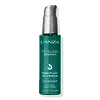What's inside
What's inside
 Key Ingredients
Key Ingredients

 Benefits
Benefits

 Concerns
Concerns

 Ingredients Side-by-side
Ingredients Side-by-side

Cyclopentasiloxane
EmollientDimethicone
EmollientCaprylyl Methicone
Skin ConditioningDiphenylsiloxy Phenyl Trimethicone
Skin ConditioningPerfluorononyl Dimethicone
Skin ConditioningMelia Azadirachta Extract
Skin ConditioningKeratin Amino Acids
Skin ConditioningSantalum Album Extract
CleansingPhellodendron Amurense Bark Extract
Skin ConditioningHordeum Distichon Extract
Skin ProtectingDimethiconol Cysteine
Ceramide NP
Skin ConditioningSodium Hyaluronate
HumectantDimethicone PEG-8 Meadowfoamate
EmollientSodium PCA
HumectantZinc PCA
HumectantMagnesium PCA
HumectantManganese PCA
HumectantCitrus Limon Fruit Extract
MaskingFumaria Officinalis Flower/Leaf/Stem Extract
Skin ConditioningHelianthus Annuus Seed Oil
EmollientSqualane
EmollientFumaric Acid
BufferingEthylhexyl Methoxycinnamate
UV AbsorberTetrahexyldecyl Ascorbate
AntioxidantTrimethylsiloxyamodimethicone
Ascorbyl Methylsilanol Pectinate
AntioxidantButylene Glycol
HumectantWater
Skin ConditioningBenzotriazolyl Dodecyl P-Cresol
UV AbsorberParfum
MaskingAlpha-Isomethyl Ionone
PerfumingBenzyl Salicylate
PerfumingButylphenyl Methylpropional
PerfumingCitronellol
PerfumingCoumarin
PerfumingGeraniol
PerfumingLimonene
PerfumingLinalool
PerfumingCyclopentasiloxane, Dimethicone, Caprylyl Methicone, Diphenylsiloxy Phenyl Trimethicone, Perfluorononyl Dimethicone, Melia Azadirachta Extract, Keratin Amino Acids, Santalum Album Extract, Phellodendron Amurense Bark Extract, Hordeum Distichon Extract, Dimethiconol Cysteine, Ceramide NP, Sodium Hyaluronate, Dimethicone PEG-8 Meadowfoamate, Sodium PCA, Zinc PCA, Magnesium PCA, Manganese PCA, Citrus Limon Fruit Extract, Fumaria Officinalis Flower/Leaf/Stem Extract, Helianthus Annuus Seed Oil, Squalane, Fumaric Acid, Ethylhexyl Methoxycinnamate, Tetrahexyldecyl Ascorbate, Trimethylsiloxyamodimethicone, Ascorbyl Methylsilanol Pectinate, Butylene Glycol, Water, Benzotriazolyl Dodecyl P-Cresol, Parfum, Alpha-Isomethyl Ionone, Benzyl Salicylate, Butylphenyl Methylpropional, Citronellol, Coumarin, Geraniol, Limonene, Linalool
Water
Skin ConditioningCetearyl Alcohol
EmollientCocos Nucifera Oil
MaskingCetyl Alcohol
EmollientCetyl Esters
EmollientLactic Acid
BufferingTocopherol
AntioxidantPhenoxyethanol
PreservativeBehentrimonium Methosulfate
Trideceth-6
EmulsifyingAnise Alcohol
PerfumingDilauryl Thiodipropionate
AntioxidantChlorhexidine Digluconate
AntimicrobialSclerocarya Birrea Seed Oil
HumectantCamellia Japonica Seed Oil
EmollientLimonene
PerfumingLinalool
PerfumingAmodimethicone
Caprylic/Capric Glycerides
EmollientGardenia Taitensis Flower
Skin ConditioningRosa Canina Flower Extract
AstringentCetrimonium Chloride
AntimicrobialCoumarin
PerfumingHexyl Cinnamal
PerfumingParfum
MaskingWater, Cetearyl Alcohol, Cocos Nucifera Oil, Cetyl Alcohol, Cetyl Esters, Lactic Acid, Tocopherol, Phenoxyethanol, Behentrimonium Methosulfate, Trideceth-6, Anise Alcohol, Dilauryl Thiodipropionate, Chlorhexidine Digluconate, Sclerocarya Birrea Seed Oil, Camellia Japonica Seed Oil, Limonene, Linalool, Amodimethicone, Caprylic/Capric Glycerides, Gardenia Taitensis Flower, Rosa Canina Flower Extract, Cetrimonium Chloride, Coumarin, Hexyl Cinnamal, Parfum
Alternatives
Ingredients Explained
These ingredients are found in both products.
Ingredients higher up in an ingredient list are typically present in a larger amount.
Coumarins are a group of substances found naturally in plants. There are over 1300 types of coumarins identified. It has a natural vanilla scent.
Coumarin is an identified EU known allergy, meaning it may cause an allergic reaction when applied to the skin.
In many countries, coumarin is banned as a food additive. However, it can be found in soaps, tobacco products, and some alcohol drinks.
Plants use coumarins as a chemical defense. Some plants that have coumarins include lavender, tonka beans, and yellow clovers.
Learn more about CoumarinLimonene is a fragrance that adds scent and taste to a formulation.
It's found in the peel oil of citrus fruits and other plants such as lavender and eucalyptus. The scent of limonene is generally described as "sweet citrus".
Limonene acts as an antioxidant, meaning it helps neutralize free radicals.
When exposed to air, oxidized limonene may sensitize the skin. Because of this, limonene is often avoided by people with sensitive skin.
The term 'fragrance' is not regulated in many countries. In many cases, it is up to the brand to define this term. For instance, many brands choose to label themselves as "fragrance-free" because they are not using synthetic fragrances. However, their products may still contain ingredients such as essential oils that are considered a fragrance.
Learn more about LimoneneLinalool is a fragrance and helps add scent to products. It's derived from common plants such as cinnamon, mint, citrus, and lavender.
Like Limonene, this ingredient oxidizes when exposed to air. Oxidized linalool can cause allergies and skin sensitivity.
This ingredient has a scent that is floral, spicy tropical, and citrus-like.
Learn more about LinaloolParfum is a catch-all term for an ingredient or more that is used to give a scent to products.
Also called "fragrance", this ingredient can be a blend of hundreds of chemicals or plant oils. This means every product with "fragrance" or "parfum" in the ingredients list is a different mixture.
For instance, Habanolide is a proprietary trade name for a specific aroma chemical. When used as a fragrance ingredient in cosmetics, most aroma chemicals fall under the broad labeling category of “FRAGRANCE” or “PARFUM” according to EU and US regulations.
The term 'parfum' or 'fragrance' is not regulated in many countries. In many cases, it is up to the brand to define this term.
For instance, many brands choose to label themselves as "fragrance-free" because they are not using synthetic fragrances. However, their products may still contain ingredients such as essential oils that are considered a fragrance by INCI standards.
One example is Calendula flower extract. Calendula is an essential oil that still imparts a scent or 'fragrance'.
Depending on the blend, the ingredients in the mixture can cause allergies and sensitivities on the skin. Some ingredients that are known EU allergens include linalool and citronellol.
Parfum can also be used to mask or cover an unpleasant scent.
The bottom line is: not all fragrances/parfum/ingredients are created equally. If you are worried about fragrances, we recommend taking a closer look at an ingredient. And of course, we always recommend speaking with a professional.
Learn more about ParfumWater. It's the most common cosmetic ingredient of all. You'll usually see it at the top of ingredient lists, meaning that it makes up the largest part of the product.
So why is it so popular? Water most often acts as a solvent - this means that it helps dissolve other ingredients into the formulation.
You'll also recognize water as that liquid we all need to stay alive. If you see this, drink a glass of water. Stay hydrated!
Learn more about Water